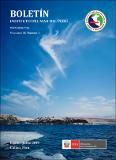Por favor, use este identificador para citar o enlazar este ítem:
https://hdl.handle.net/20.500.12958/3360| Título : | Características de irradiancia espectral del mar y de la zona costera de Moquegua y Tacna durante setiembre 2017 |
| Otros títulos : | Characteristics of the spectral irradiance in the sea and coastal area of Moquegua and Tacna in September 2017 |
| Autor : | Paulino Rojas, Carlos Villegas Apaza, Piero Polar, Mario |
| Palabras clave : | Sedimentos;Fondos marinos;Zona costera;Espectroradiómetro;Moquegua |
| Fecha de publicación : | 2019 |
| Editorial : | Instituto del Mar del Perú |
| Citación : | Bol Inst Mar Perú. 34(1) 2019: p.80-90 |
| Citación : | Boletín IMARPE;34(1), 2019 |
| Resumen : | Se efectuó un análisis de firmas espectrales colectadas en mar, muestras de sedimentos de fondo marino y de rocas expuestas en playa con el espectroradiómetro Apogee PS-100. El propósito fue identificar características espectrales del ambiente marino. La respuesta espectral de las estaciones en mar estuvo en función del contenido de partículas en suspensión como sedimentos, organismos biológicos (microalgas) e intensidad de radiación solar al momento del registro de la información. Mayores valores de irradiancia se detectaron en las estaciones M-03 (0,069), M-04 (0,122) y M-05 (0,197) watts/m2, que coincidieron con incremento de concentración de clorofila-a satelital en cada estación. Se identificó la respuesta espectral de la composición de las rocas expuestas y de pequeñas piedras que caracterizan la playa Escoria en Ilo. En rocas negras se detectó alta absorción y baja irradiancia (<0,04 watts/m2) en todo el rango del espectro, rocas de color ocre presentaron mayor irradiancia entre 600 y 800 nm (0,14 watts/m2) indicando contenido mineral. Rocas con organismos algales verdes mostraron mayor irradiancia 485 nm (0,30 watts/m2) y máxima absorbancia en los 550 nm. Las firmas espectrales de muestras de sedimentos de fondo presentan similar respuesta espectral debido a que contienen diferentes porcentajes del mismo contenido de sedimentos y de organismos biológicos. ABSTRACT: An analysis of the spectral signatures collected at sea, samples of marine bottom sediments and exposed rocks on the beach with the Apogee PS-100 spectroradiometer, was carried out. The purpose was to identify the spectral characteristics of the marine environment. It was evidenced that the spectral response of marine stations was related to the content of suspended particles such as sediments, biological organisms (microalgae) and intensity of solar radiation at the moment of recording the information. Higher irradiance values occurred at stations M-03 (0.069), M-04 (0.122) and M-05 (0.197) watts/m2, which coincided with an increase in the satellite chlorophyll-a concentration in each station. The spectral response of the composition of the exposed rocks and small stones that characterize the Escoria beach in Ilo was identified. The black rocks showed high absorption and low irradiance (<0.04 watts/m2) over the entire spectrum range, the ocher-colored ones showed higher irradiance between 600 and 800 nm (0.14 watts/m2) indicating mineral content. Rocks containing green algal organisms showed higher irradiance 485 nm (0.30 watts/m2) and a maximum absorbance at 550 nm. The spectral signatures of the bottom sediment samples have a similar spectral response because they contain different percentages of the same content of sediments and biological organisms. |
| URI : | https://hdl.handle.net/20.500.12958/3360 |
| ISSN : | 03787702 |
| Aparece en las colecciones: | Boletín 34(1), 2019 |
Ficheros en este ítem:
| Fichero | Descripción | Tamaño | Formato | |
|---|---|---|---|---|
| Boletin 34(1)-7.pdf | 1,34 MB | Adobe PDF |  Visualizar/Abrir |
Este ítem está sujeto a una licencia Creative Commons Licencia Creative Commons

